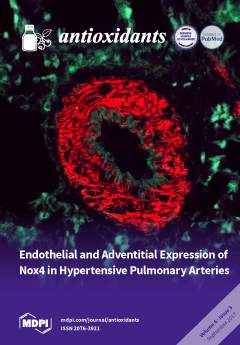In a previous study, the detailed low-molecular weight polyphenolic profile of the different plant parts (leaves, stem, bark and wood) of
Uncaria tomentosa was reported, the leaves being the plant part with the highest phenolic content and presenting the most heterogenous proanthocyanidin composition.
[...] Read more.
In a previous study, the detailed low-molecular weight polyphenolic profile of the different plant parts (leaves, stem, bark and wood) of
Uncaria tomentosa was reported, the leaves being the plant part with the highest phenolic content and presenting the most heterogenous proanthocyanidin composition. Further, cytotoxicity of leaves extracts in two cancer cell lines was also found to be higher than in the remaining parts of the plant. In the present study, fractioning of
U. tomentosa leaves polyphenolic extracts was performed using Diaion
® HP-20 resin and a detailed characterization and quantification of fractions (
n = 5) was achieved using advanced analytical techniques such as Ultra-Performance Liquid Chromatography coupled with Electrospray Ionization and Triple Quadrupole (TQD) Tandem Mass Spectrometry (UPLC/TQ-ESI-MS) and
13C-NMR. Oxygen Radical Absorbance Capacity (ORAC) and cytotoxicity on gastric adenocarcinoma AGS and colon adenocarcinoma SW20 cell lines were also determined in the different fractions. Results showed selective distribution of 32 non-flavonoid and flavonoid phenolics among the different fractions. ORAC varied between 3.2 and 11.8 μmol TE/mg in the different fractions, whereas IC
50 of cytotoxicity on gastric adenocarcinoma AGS and colon adenocarcinoma SW20 cell lines best values were between 71.4 and 75.6 µg/mL. Fractions rich in proanthocyanidins also showed the highest bioactivity. In fact, significant positive correlation was found between total proanthocyanidins (TP) quantified by UPLC-DAD and ORAC (
R2 = 0.970), whereas significant negative correlation was found between TP and cytotoxicity towards AGS (
R2 = 0.820) and SW620 (
R2 = 0.843) adenocarcinoma cell lines. Among proanthocyanidins, propelargonidin dimers were of particular interest, showing significant correlation with cytotoxic selectivity on both gastric AGS (
R2 = 0.848) and colon SW620 (
R2 = 0.883) adenocarcinoma cell lines. These results show further evidence of the bioactivity of
U. tomentosa proanthocyanidin extracts and their potential health effects.
Full article






